FORD EXPLORER 2012 5.G Owners Manual
Manufacturer: FORD, Model Year: 2012, Model line: EXPLORER, Model: FORD EXPLORER 2012 5.GPages: 439, PDF Size: 3.63 MB
Page 331 of 439
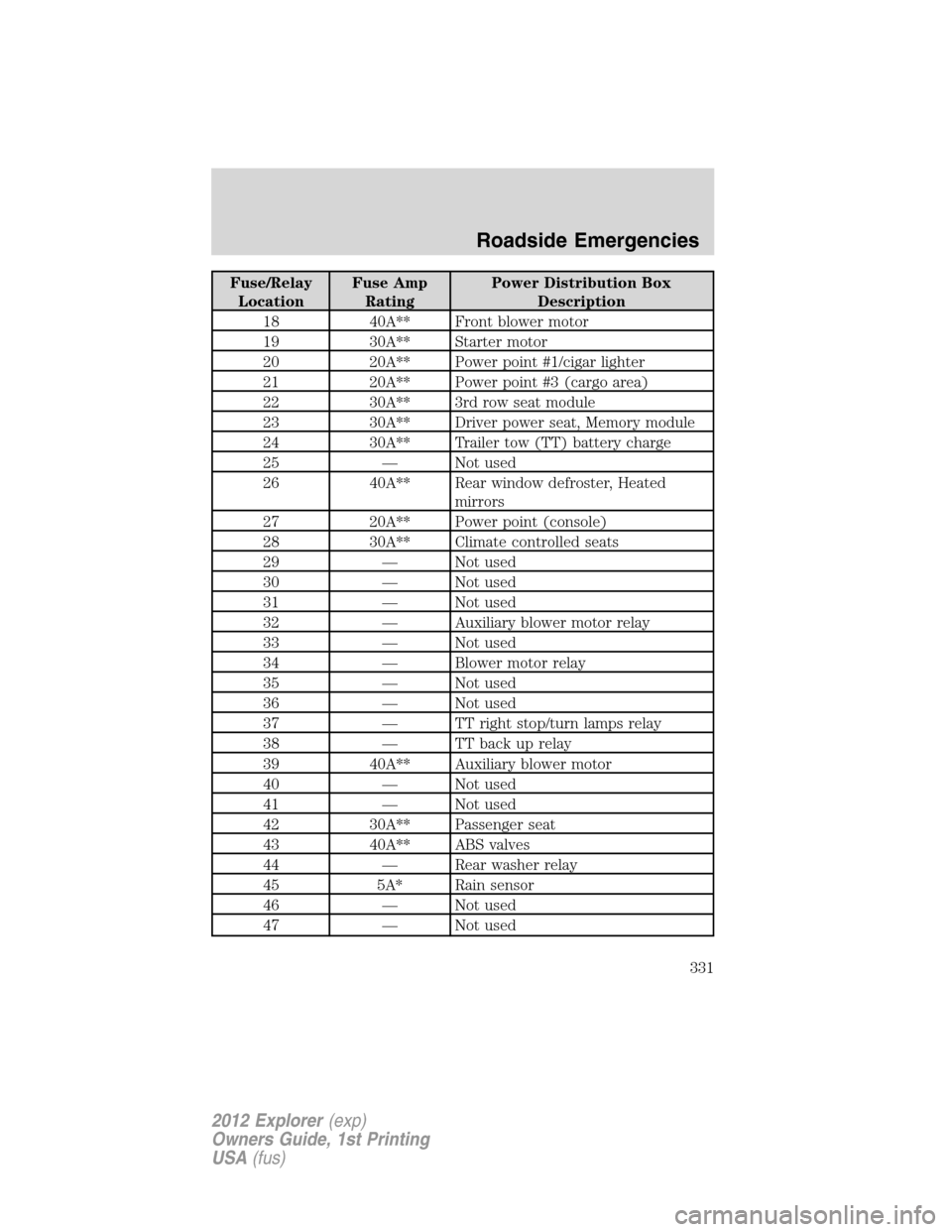
Fuse/Relay
LocationFuse Amp
RatingPower Distribution Box
Description
18 40A** Front blower motor
19 30A** Starter motor
20 20A** Power point #1/cigar lighter
21 20A** Power point #3 (cargo area)
22 30A** 3rd row seat module
23 30A** Driver power seat, Memory module
24 30A** Trailer tow (TT) battery charge
25 — Not used
26 40A** Rear window defroster, Heated
mirrors
27 20A** Power point (console)
28 30A** Climate controlled seats
29 — Not used
30 — Not used
31 — Not used
32 — Auxiliary blower motor relay
33 — Not used
34 — Blower motor relay
35 — Not used
36 — Not used
37 — TT right stop/turn lamps relay
38 — TT back up relay
39 40A** Auxiliary blower motor
40 — Not used
41 — Not used
42 30A** Passenger seat
43 40A** ABS valves
44 — Rear washer relay
45 5A* Rain sensor
46 — Not used
47 — Not used
Roadside Emergencies
331
2012 Explorer(exp)
Owners Guide, 1st Printing
USA(fus)
Page 332 of 439
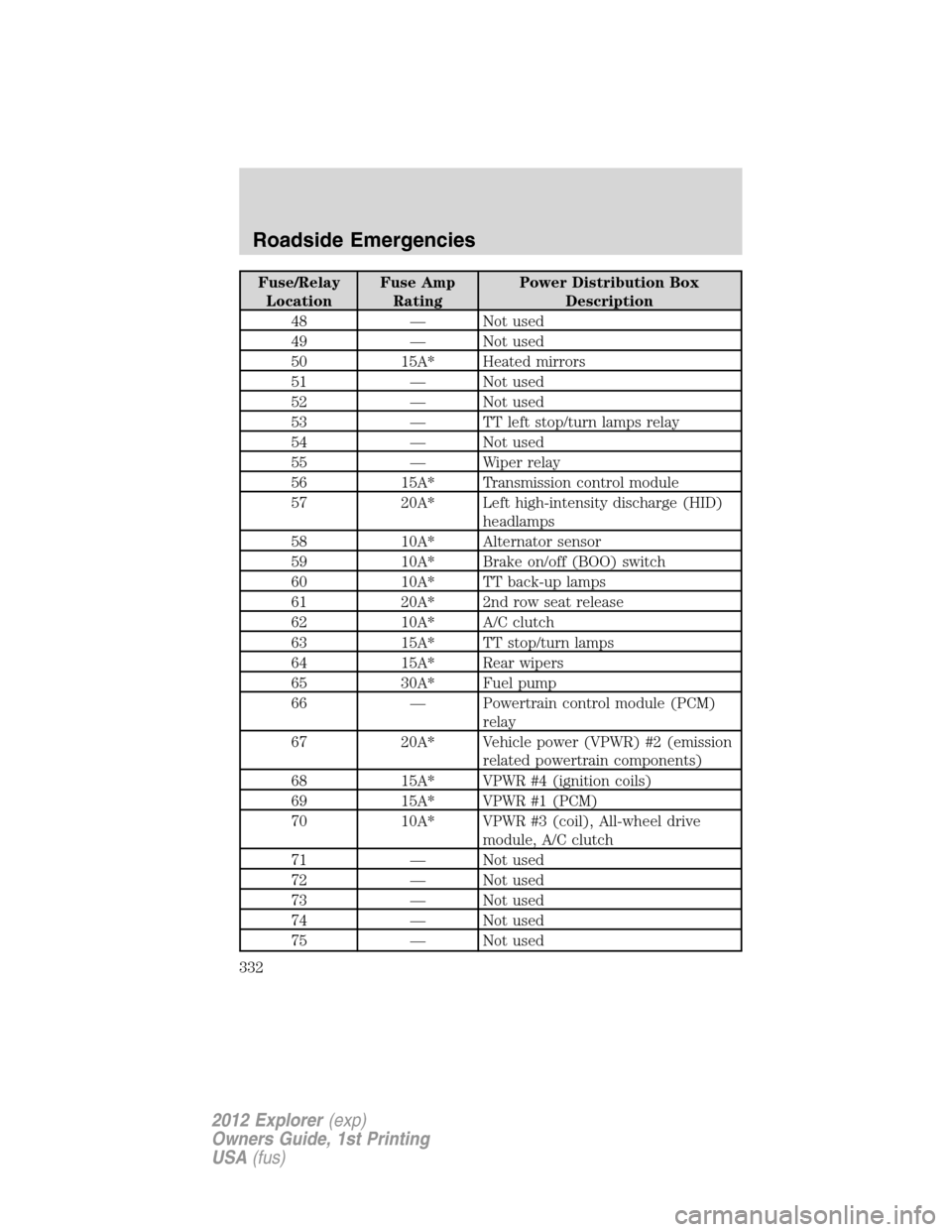
Fuse/Relay
LocationFuse Amp
RatingPower Distribution Box
Description
48 — Not used
49 — Not used
50 15A* Heated mirrors
51 — Not used
52 — Not used
53 — TT left stop/turn lamps relay
54 — Not used
55 — Wiper relay
56 15A* Transmission control module
57 20A* Left high-intensity discharge (HID)
headlamps
58 10A* Alternator sensor
59 10A* Brake on/off (BOO) switch
60 10A* TT back-up lamps
61 20A* 2nd row seat release
62 10A* A/C clutch
63 15A* TT stop/turn lamps
64 15A* Rear wipers
65 30A* Fuel pump
66 — Powertrain control module (PCM)
relay
67 20A* Vehicle power (VPWR) #2 (emission
related powertrain components)
68 15A* VPWR #4 (ignition coils)
69 15A* VPWR #1 (PCM)
70 10A* VPWR #3 (coil), All-wheel drive
module, A/C clutch
71 — Not used
72 — Not used
73 — Not used
74 — Not used
75 — Not used
Roadside Emergencies
332
2012 Explorer(exp)
Owners Guide, 1st Printing
USA(fus)
Page 333 of 439
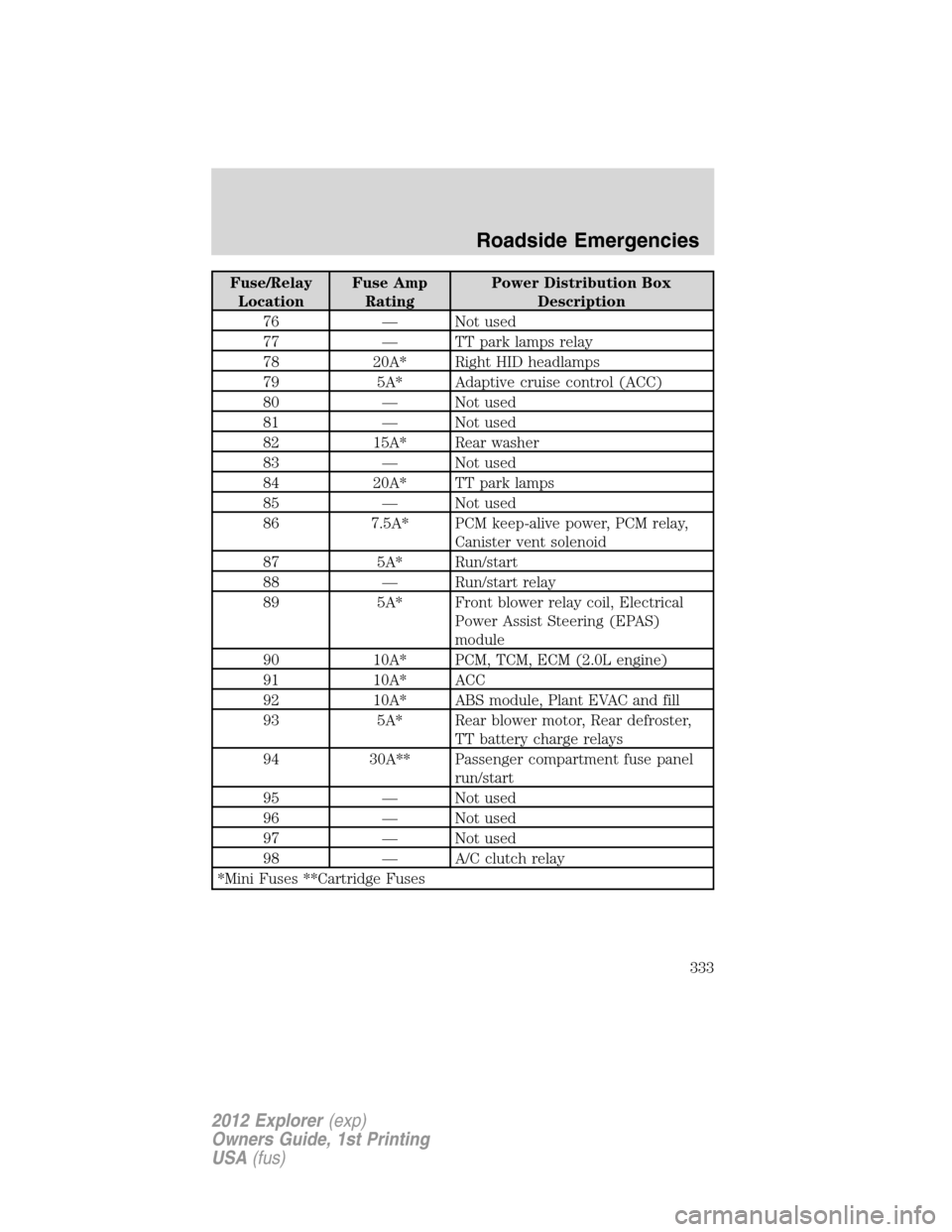
Fuse/Relay
LocationFuse Amp
RatingPower Distribution Box
Description
76 — Not used
77 — TT park lamps relay
78 20A* Right HID headlamps
79 5A* Adaptive cruise control (ACC)
80 — Not used
81 — Not used
82 15A* Rear washer
83 — Not used
84 20A* TT park lamps
85 — Not used
86 7.5A* PCM keep-alive power, PCM relay,
Canister vent solenoid
87 5A* Run/start
88 — Run/start relay
89 5A* Front blower relay coil, Electrical
Power Assist Steering (EPAS)
module
90 10A* PCM, TCM, ECM (2.0L engine)
91 10A* ACC
92 10A* ABS module, Plant EVAC and fill
93 5A* Rear blower motor, Rear defroster,
TT battery charge relays
94 30A** Passenger compartment fuse panel
run/start
95 — Not used
96 — Not used
97 — Not used
98 — A/C clutch relay
*Mini Fuses **Cartridge Fuses
Roadside Emergencies
333
2012 Explorer(exp)
Owners Guide, 1st Printing
USA(fus)
Page 334 of 439
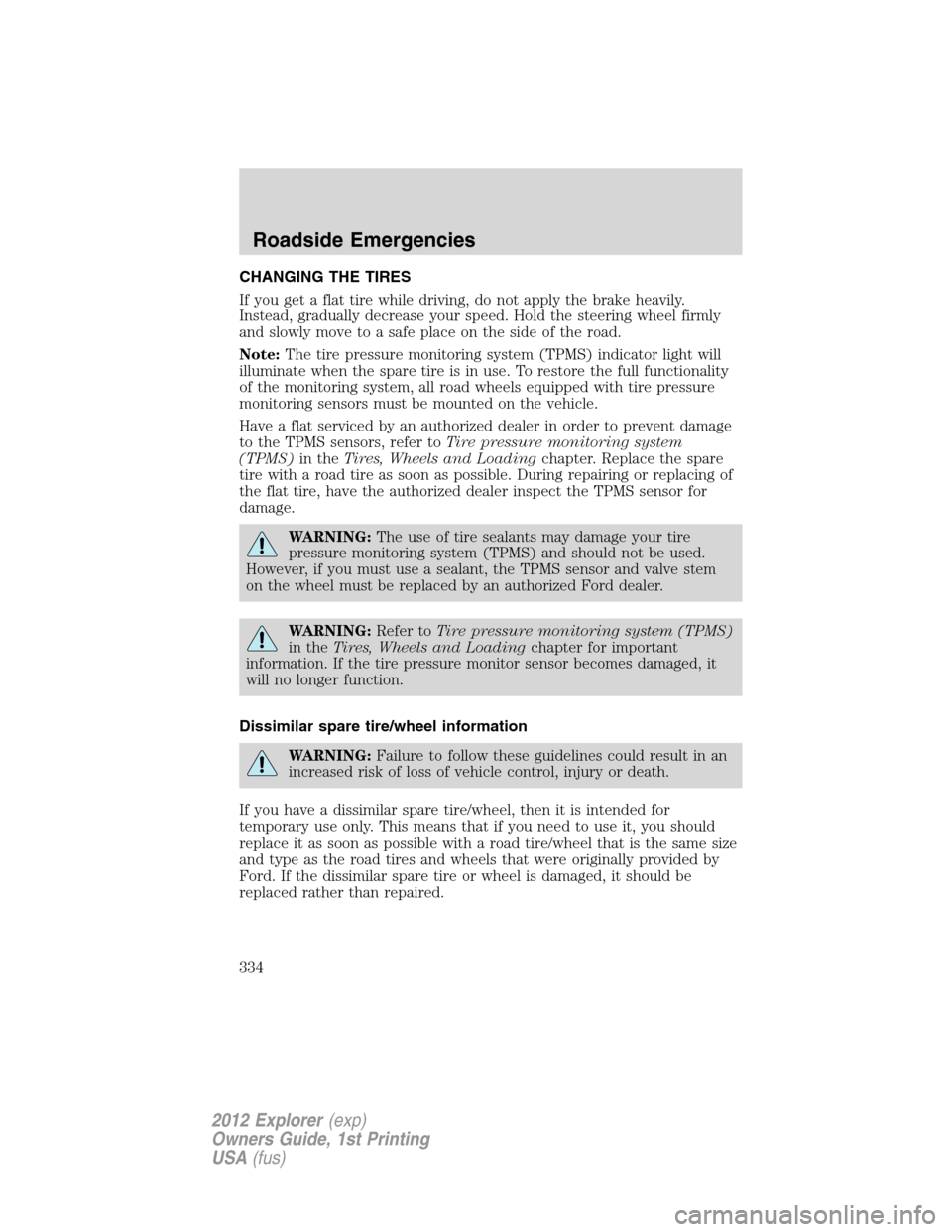
CHANGING THE TIRES
If you get a flat tire while driving, do not apply the brake heavily.
Instead, gradually decrease your speed. Hold the steering wheel firmly
and slowly move to a safe place on the side of the road.
Note:The tire pressure monitoring system (TPMS) indicator light will
illuminate when the spare tire is in use. To restore the full functionality
of the monitoring system, all road wheels equipped with tire pressure
monitoring sensors must be mounted on the vehicle.
Have a flat serviced by an authorized dealer in order to prevent damage
to the TPMS sensors, refer toTire pressure monitoring system
(TPMS)in theTires, Wheels and Loadingchapter. Replace the spare
tire with a road tire as soon as possible. During repairing or replacing of
the flat tire, have the authorized dealer inspect the TPMS sensor for
damage.
WARNING:The use of tire sealants may damage your tire
pressure monitoring system (TPMS) and should not be used.
However, if you must use a sealant, the TPMS sensor and valve stem
on the wheel must be replaced by an authorized Ford dealer.
WARNING:Refer toTire pressure monitoring system (TPMS)
in theTires, Wheels and Loadingchapter for important
information. If the tire pressure monitor sensor becomes damaged, it
will no longer function.
Dissimilar spare tire/wheel information
WARNING:Failure to follow these guidelines could result in an
increased risk of loss of vehicle control, injury or death.
If you have a dissimilar spare tire/wheel, then it is intended for
temporary use only. This means that if you need to use it, you should
replace it as soon as possible with a road tire/wheel that is the same size
and type as the road tires and wheels that were originally provided by
Ford. If the dissimilar spare tire or wheel is damaged, it should be
replaced rather than repaired.
Roadside Emergencies
334
2012 Explorer(exp)
Owners Guide, 1st Printing
USA(fus)
Page 335 of 439
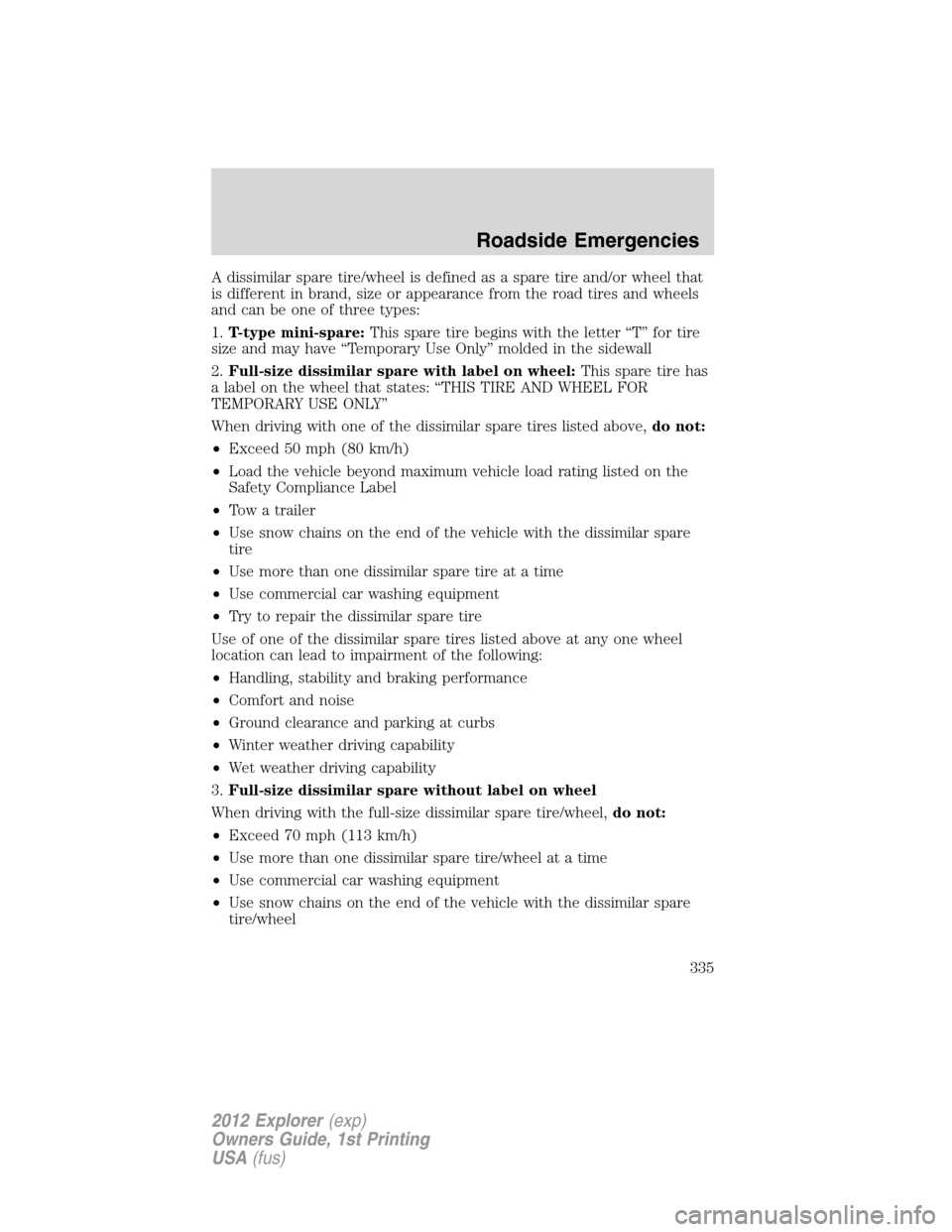
A dissimilar spare tire/wheel is defined as a spare tire and/or wheel that
is different in brand, size or appearance from the road tires and wheels
and can be one of three types:
1.T-type mini-spare:This spare tire begins with the letter “T” for tire
size and may have “Temporary Use Only” molded in the sidewall
2.Full-size dissimilar spare with label on wheel:This spare tire has
a label on the wheel that states: “THIS TIRE AND WHEEL FOR
TEMPORARY USE ONLY”
When driving with one of the dissimilar spare tires listed above,do not:
•Exceed 50 mph (80 km/h)
•Load the vehicle beyond maximum vehicle load rating listed on the
Safety Compliance Label
•Tow a trailer
•Use snow chains on the end of the vehicle with the dissimilar spare
tire
•Use more than one dissimilar spare tire at a time
•Use commercial car washing equipment
•Try to repair the dissimilar spare tire
Use of one of the dissimilar spare tires listed above at any one wheel
location can lead to impairment of the following:
•Handling, stability and braking performance
•Comfort and noise
•Ground clearance and parking at curbs
•Winter weather driving capability
•Wet weather driving capability
3.Full-size dissimilar spare without label on wheel
When driving with the full-size dissimilar spare tire/wheel,do not:
•Exceed 70 mph (113 km/h)
•Use more than one dissimilar spare tire/wheel at a time
•Use commercial car washing equipment
•Use snow chains on the end of the vehicle with the dissimilar spare
tire/wheel
Roadside Emergencies
335
2012 Explorer(exp)
Owners Guide, 1st Printing
USA(fus)
Page 336 of 439
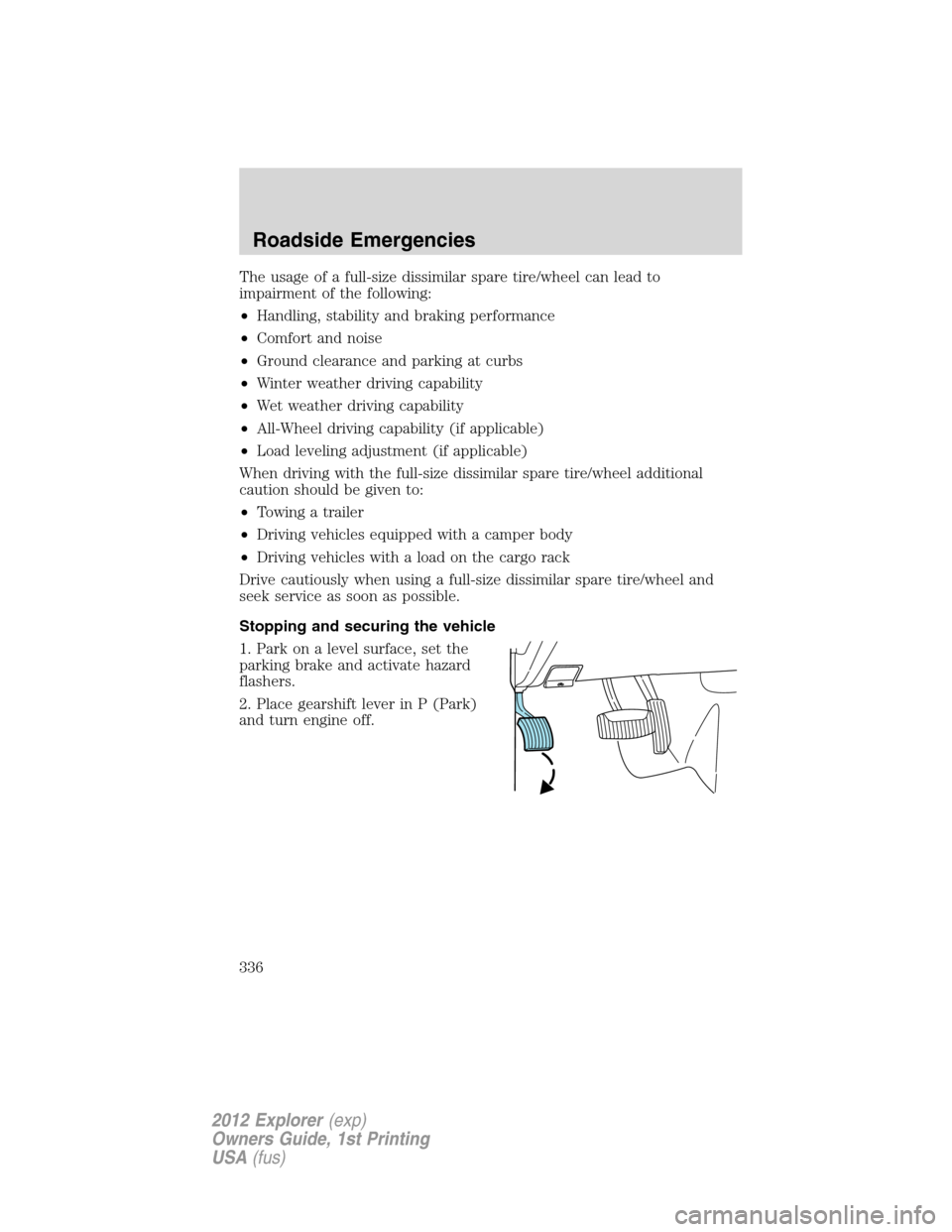
The usage of a full-size dissimilar spare tire/wheel can lead to
impairment of the following:
•Handling, stability and braking performance
•Comfort and noise
•Ground clearance and parking at curbs
•Winter weather driving capability
•Wet weather driving capability
•All-Wheel driving capability (if applicable)
•Load leveling adjustment (if applicable)
When driving with the full-size dissimilar spare tire/wheel additional
caution should be given to:
•Towing a trailer
•Driving vehicles equipped with a camper body
•Driving vehicles with a load on the cargo rack
Drive cautiously when using a full-size dissimilar spare tire/wheel and
seek service as soon as possible.
Stopping and securing the vehicle
1. Park on a level surface, set the
parking brake and activate hazard
flashers.
2. Place gearshift lever in P (Park)
and turn engine off.
Roadside Emergencies
336
2012 Explorer(exp)
Owners Guide, 1st Printing
USA(fus)
Page 337 of 439
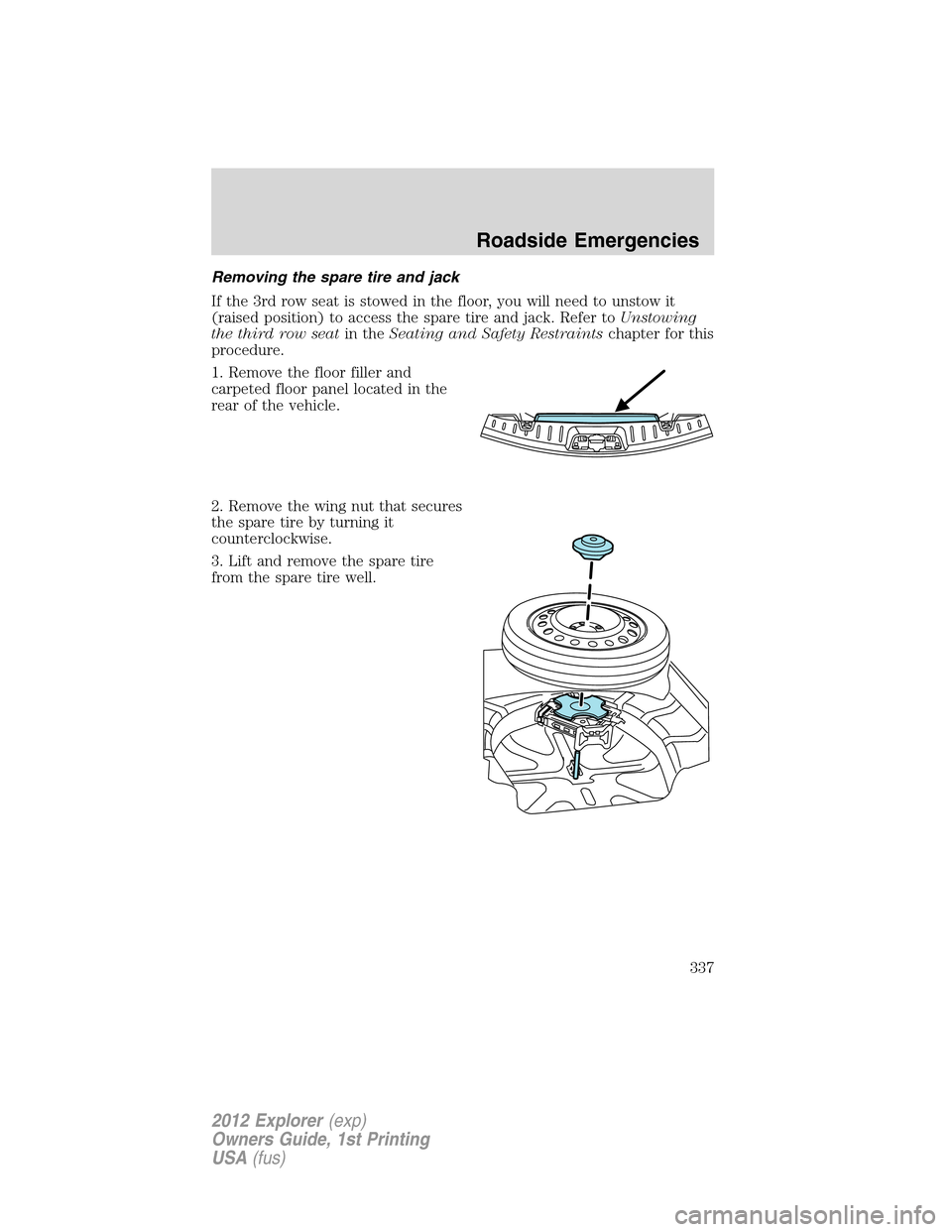
Removing the spare tire and jack
If the 3rd row seat is stowed in the floor, you will need to unstow it
(raised position) to access the spare tire and jack. Refer toUnstowing
the third row seatin theSeating and Safety Restraintschapter for this
procedure.
1. Remove the floor filler and
carpeted floor panel located in the
rear of the vehicle.
2. Remove the wing nut that secures
the spare tire by turning it
counterclockwise.
3. Lift and remove the spare tire
from the spare tire well.
Roadside Emergencies
337
2012 Explorer(exp)
Owners Guide, 1st Printing
USA(fus)
Page 338 of 439
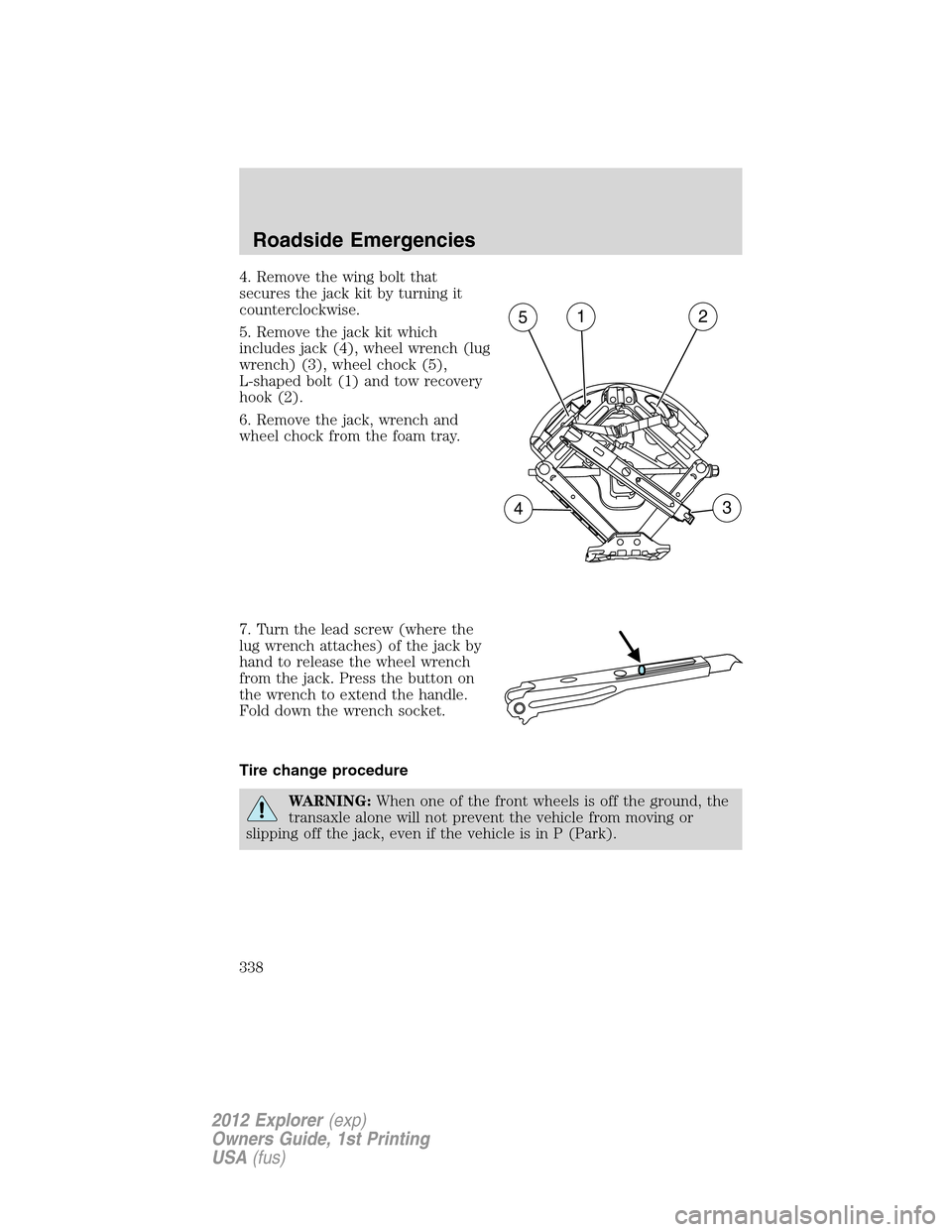
4. Remove the wing bolt that
secures the jack kit by turning it
counterclockwise.
5. Remove the jack kit which
includes jack (4), wheel wrench (lug
wrench) (3), wheel chock (5),
L-shaped bolt (1) and tow recovery
hook (2).
6. Remove the jack, wrench and
wheel chock from the foam tray.
7. Turn the lead screw (where the
lug wrench attaches) of the jack by
hand to release the wheel wrench
from the jack. Press the button on
the wrench to extend the handle.
Fold down the wrench socket.
Tire change procedure
WARNING:When one of the front wheels is off the ground, the
transaxle alone will not prevent the vehicle from moving or
slipping off the jack, even if the vehicle is in P (Park).
25
43
1
Roadside Emergencies
338
2012 Explorer(exp)
Owners Guide, 1st Printing
USA(fus)
Page 339 of 439
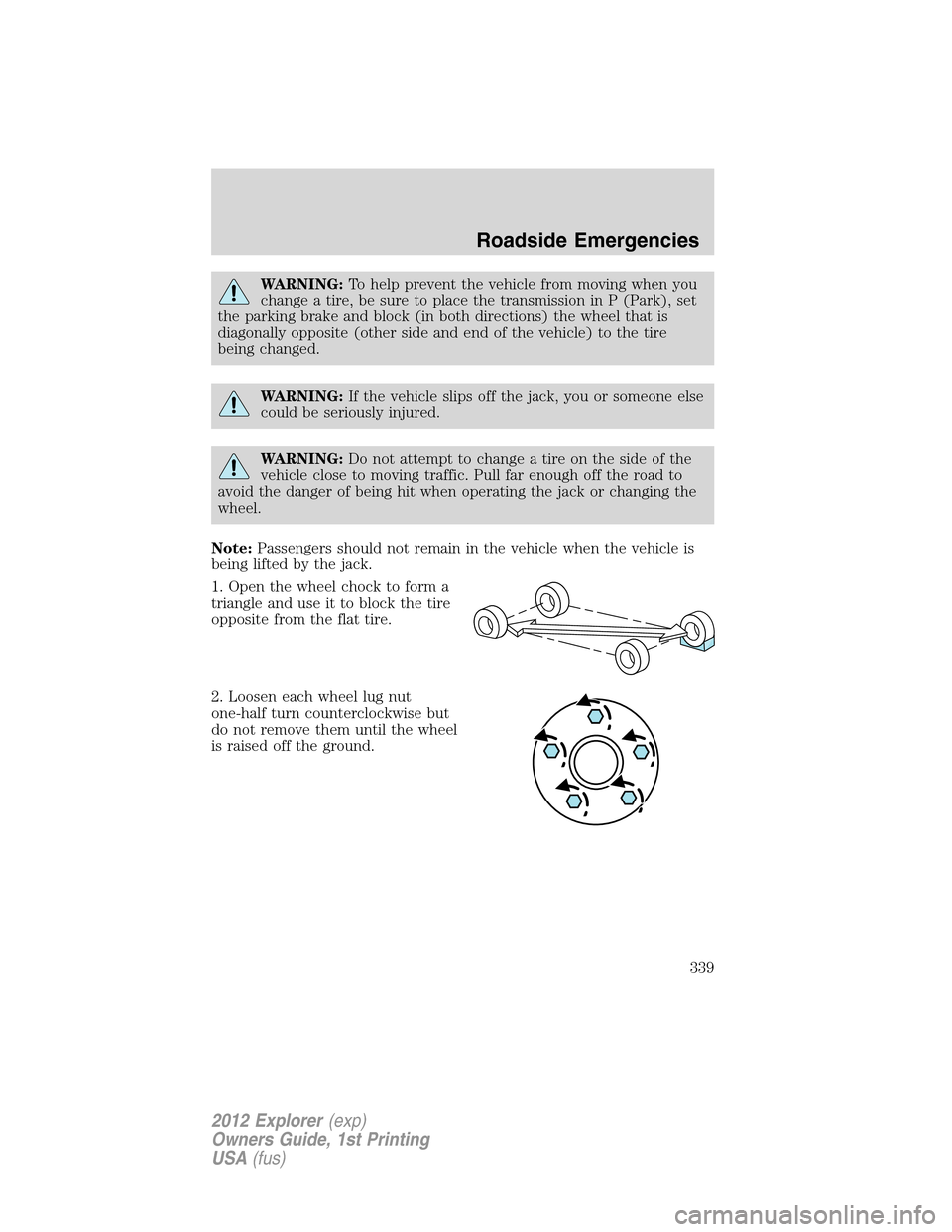
WARNING:To help prevent the vehicle from moving when you
change a tire, be sure to place the transmission in P (Park), set
the parking brake and block (in both directions) the wheel that is
diagonally opposite (other side and end of the vehicle) to the tire
being changed.
WARNING:If the vehicle slips off the jack, you or someone else
could be seriously injured.
WARNING:Do not attempt to change a tire on the side of the
vehicle close to moving traffic. Pull far enough off the road to
avoid the danger of being hit when operating the jack or changing the
wheel.
Note:Passengers should not remain in the vehicle when the vehicle is
being lifted by the jack.
1. Open the wheel chock to form a
triangle and use it to block the tire
opposite from the flat tire.
2. Loosen each wheel lug nut
one-half turn counterclockwise but
do not remove them until the wheel
is raised off the ground.
Roadside Emergencies
339
2012 Explorer(exp)
Owners Guide, 1st Printing
USA(fus)
Page 340 of 439
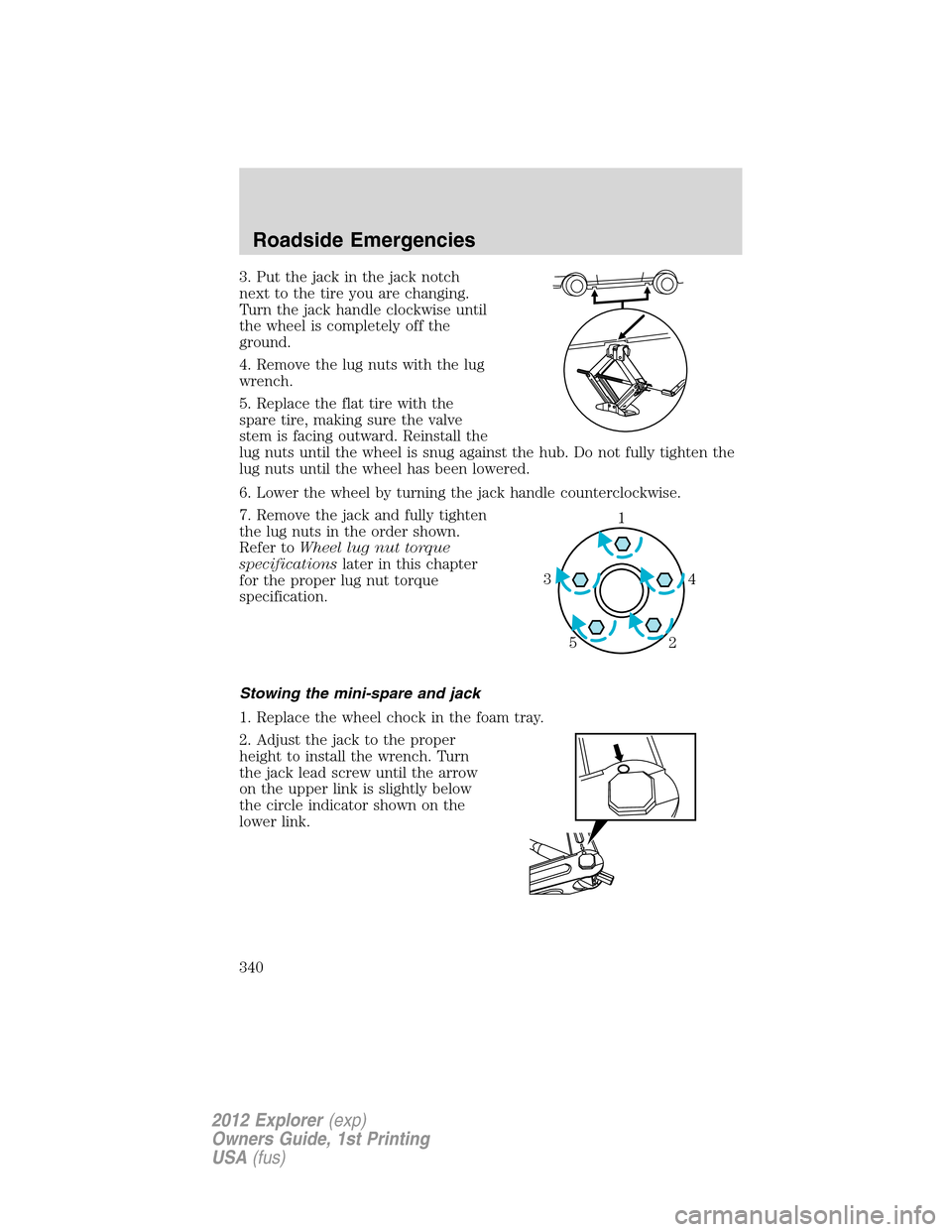
3. Put the jack in the jack notch
next to the tire you are changing.
Turn the jack handle clockwise until
the wheel is completely off the
ground.
4. Remove the lug nuts with the lug
wrench.
5. Replace the flat tire with the
spare tire, making sure the valve
stem is facing outward. Reinstall the
lug nuts until the wheel is snug against the hub. Do not fully tighten the
lug nuts until the wheel has been lowered.
6. Lower the wheel by turning the jack handle counterclockwise.
7. Remove the jack and fully tighten
the lug nuts in the order shown.
Refer toWheel lug nut torque
specificationslater in this chapter
for the proper lug nut torque
specification.
Stowing the mini-spare and jack
1. Replace the wheel chock in the foam tray.
2. Adjust the jack to the proper
height to install the wrench. Turn
the jack lead screw until the arrow
on the upper link is slightly below
the circle indicator shown on the
lower link.
1
4 3
2 5
Roadside Emergencies
340
2012 Explorer(exp)
Owners Guide, 1st Printing
USA(fus)